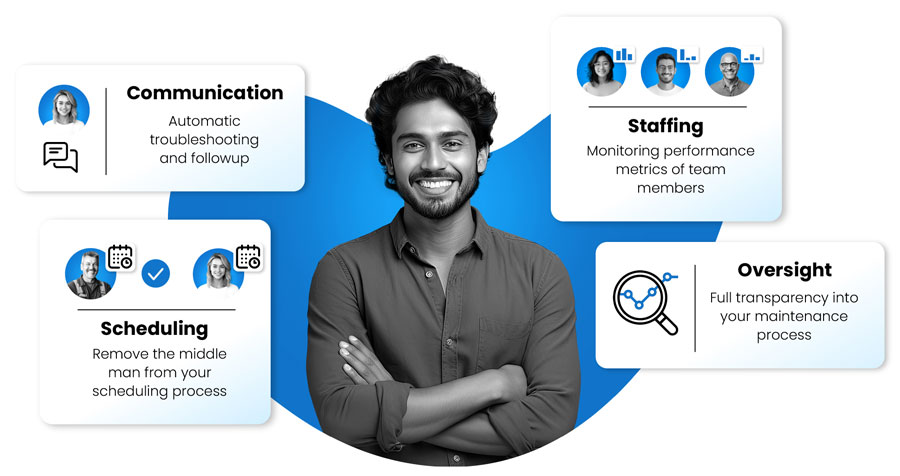A quality Maintenance Satisfaction Program means happier residents. Happier residents translate to better reviews and higher resident retention. Positive reviews and resident retention lead to increased revenue and fewer resident turnover responsibilities. It’s rather simple mathematics.

The Challenge
Confidently knowing your process is up to snuff. To that end, we took a look at how maintenance processes can look in an effort to determine how it should look. Here’s what we found.
In our analysis, the workflow of any maintenance request has a few essential steps:
Receive maintenance request
Coordinate technician and resident schedules
Dispatch technician
Follow-up with technician and resident on the scheduling of repair
Verify work is complete
Receive resident review
We’ve found that no matter if it’s handled internally or externally, the processes are nearly identical. The questions both processes should seek to answer are, too.
Did the technician receive the work order?
Do they intend to take the job?
Did they reach the resident?
Was a time scheduled?
Is the repair complete?
Is the resident satisfied?
The similarities between internal and external processes may mean it’s easy to go between one and the other. But that ease of use comes with a catch: a repair job can “fall through the cracks” in either system. So, how do you craft a consistent and successful process that avoids costly mistakes? Here are a few tips.
Checking Checkpoints
Creating a step-by-step process for tracking repairs is a great move. But it’s ultimately of little use if you do not or cannot confirm those steps are being reached in a timely, efficient manner. Thus, one of the most important concepts in a successful maintenance repair process is verifying the important checkpoints are being met.
The first checkpoint your process should be able to verify is that the job has been received and accepted by a technician. The next step is to then confirm an appointment has been made between the resident and technician.
In a perfect world, this step is automated with Meld software, where property managers can easily go onto their dashboard and see where each repair job is in the process.
But regardless of how this checkpoint is met, we recommend you do not wait any longer than 24 hours after a technician accepts a job before you check-in and ensure an appointment has been scheduled. This step is also important because of the next checkpoint: verifying the job was completed.
At this point in the process, you should know when the job is expected to be finished. The next checkpoint is to verify the job is done. We’ve seen companies skip this step and rely on the receipt of an invoice to confirm the job was completed. But it can sometimes take weeks to receive an invoice, way longer than most residents’ patience. By failing to confirm the quick completion of a maintenance issue, you’re setting yourself up for failure, negative reviews, headaches and lost revenue.
The final important verification step is quite obvious: ensuring your resident is satisfied with the job. A resident with a bad maintenance experience usually won’t wait for your call to express their frustration. Either they’ll call you and turn an ordinary job into an all-hands-on-deck emergency, or they’ll write your company a poor review. By checking in with residents shortly after a job is complete, you can get ahead of the problem and frustration, thereby preventing negative reviews.
Success Looks Like This
A maintenance repair process with systematic checkpoints and verifications is the best way to ensure residents are happy and business is booming. But in the early going, it can be difficult to gauge if your system is leading to successful outcomes. Acknowledging that everyone’s
definition of success can be different, we’ve nonetheless found three measurements that are especially useful in determining whether your process is working or not.
Speed of repair
Resident satisfaction
Cost
There is a direct correlation between how quickly a repair is completed and how satisfied a resident is with the job. But you may be surprised to know how little time you truly have to address the issue. According to our analysis, issues that take longer than seven days to fix have close to zero chance of receiving a positive review. If the issue is related to an HVAC system, you have even less time: usually no more than three days. In the end, measuring the speed of a repair job is important insomuch as it’s directly related to resident satisfaction, the ultimate measure of how your maintenance process is working.
We’d be remiss if we didn’t address the cost of a repair job.
Receiving positive review after positive review is great for retaining residents and attracting new ones but is of little practical use if you’re hemorrhaging money in its pursuit.
To keep costs down, it’s important to craft strong relationships with quality technicians/vendors. Such relationships can translate to your company receiving priority over others when a technician has multiple jobs to address. It can also lead to better contract terms and the possibility of negotiated pricing. Working with a quality vendor interested in your company’s well-being may also mean sidestepping large, costly, “emergency” repairs. How? A quality vendor will be able to spot potential problems and approaching system failures before they reach that point and with a strong relationship, you can trust they are looking out for your business, not just theirs. As they say, an ounce of prevention is worth a pound of cure.
Putting It Into Practice
Ask 10 property managers what a successful maintenance process looks like and you’ll probably get 11 answers. Yet we think we’ve found the only answer you really need: Meld software. With our software, the tracking and verification of checkpoints for each maintenance job can be automated and reported in real-time by the technician handling the issue. This means you can easily check on a job to see the details of where it is in your process, and technicians can report on the status as they move through each step, saving you the hassle of checking on things yourself.
We understand that change can be daunting. But with an efficient system in place for the handling of maintenance issues, you’ll ultimately save time, money and stress.
And with automation and the tried and true system offered by Meld software, changing your process is easier than ever. Leave bad reviews and messy maintenance in the past by streamlining your process and reap the reward of happy residents, happier investors and stress-free property maintenance.













